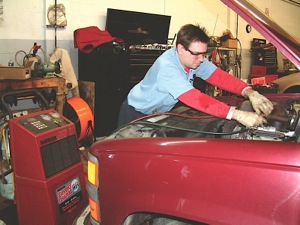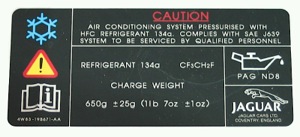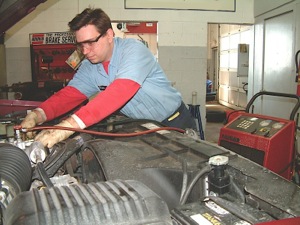By Bob Pattengale, aftermarket trainer
In the world of public opinion, if you were asked if your technicians were overcharging your customers, you might interpret that as an issue pertaining to the customer’s repair bill.
However, in the world of mobile air conditioning service, we’re referring to the problem of some vehicle A/C systems being (unknowingly) charged with too much refrigerant.
While A/C performance problems due to too much refrigerant in the system have basically become an issue in recent years, its origins began many years ago.
When we look at the refrigerant demands on older R-12 vehicles, A/C systems operated on as much as 55 to 60 ounces!
In fact, back when I first started as a technician, we used to have stacks of cans in cases, and you put two to three cans in the car and then you’d toss the leftover refrigerant in the trashcan. You didn’t care about it.
It was cheap, and there was a lot to go in there. 
Today’s R134-a systems have 12 to 16 ounces of refrigerant to deal with. Now, what are the changes? What are the differences there?
Remember, back in the old days, you had a very large air conditioning compressor. That thing took three to four pounds of refrigerant, and when you pushed the button to turn the air conditioning on, you felt a decrease in performance of the vehicle. That’s because it took a lot of horsepower to push that refrigerant through the air conditioning system.
Today, it’s a much smaller deal; the smaller compressor takes a lot less energy.
Now, in most cases today, if you’re running around in a Toyota Corolla or maybe a little Nissan Sentra or small vehicle, when you turn on the air conditioning, you don’t even feel the effects.
Why is that?
There’s a lot less refrigerant in the system that we have to deal with. Now, global warming is certainly a concern, which is one reason why OEMs began reducing the size of A/C systems. The other concern is mileage.
If I have a large compressor, and I’m trying to get more gallons per mile out of the vehicle, what you have to do is decrease the size of that compressor.
So, if I have an extremely large compressor, I’m going to use more gas. If I have a very small compressor, I’m going to be able to get more gas mileage out of the vehicle. And, I’m going to put less load on the engine itself.
So that’s why we see a transition to these smaller systems, primarily to get that gas mileage taken care of.
 Equipment Test
Equipment Test
When the Mobile Air Conditioning Society Worldwide (MACS) conducted its studies in 2007 on J2788, the SAE standard that deals with A/C recovery and recharge equipment, it led to some interesting results.
In its findings, MACS concluded that even with the best machines out there, you were not going to pull all of the refrigerant out of an A/C system during service.
According to MACS’ research, the organization went out and purchased just standard run-of-the-mill air conditioning machines from shops. Some of these had been well maintained, while others were poorly maintained. The MACS team brought the equipment together and began a testing process to determine how well they worked.
Depending upon the ambient temperature, some of the machines could not pull out more than 50% of the refrigerant. So, let this sink into your head: If you only pulled 50% of the remaining refrigerant in the system out, you left 50% behind. If you add another full charge on top of that, you have added full refrigerant on top of left-behind refrigerant.
Now, I’m talking about a car that was blowing cool, not cold. And, I’m not talking about one that had the A/C compressor replaced, where it was empty. This is a customer that came in and said, “Hey, it’s not blowing as cold as it was last year, I want it cold this year.”
So, to address the customer’s needs, what your tech does is roll the machine up, and perform a complete cycle — recover it, recycle it, do a vacuum and a recharge to get the customer going. And, that’s the scenario where the chances are highly likely that your tech left refrigerant behind.
Let’s take a look at a couple more items.
Even the best machine that they could find would only pull 70% of the refrigerant out at a 50° temperature range.
Now, why 50° temperature? This is based upon average temperature around the country, and they use that as a standard for testing. We’re going to look at a couple of examples where the car was warmed up and the temperature (ambient temperature) was higher.
So, even in good climate control, even the best machine that they could find, the equipment operator is still going to leave some refrigerant behind. Now, that surprised me. I was shocked, really, when I looked at the differences between J2810 and J2788.
Here is another real-world example. A customer comes into the shop with the complaint that the A/C’s blowing cool, but not cold. Checking under the hood, we find that it’s a 16-ounce system.
And, I suspect, that it’s at least four to six ounces low, because the performance has reached the point where the temperature is increasing.
This is an expansion valve car, so we predict that when it gets about 30% to 40% low on charge, that we’re going to have an issue with the air conditioning performance.
Now, let’s take this example a little bit further. Let’s say you had a machine that is poorly maintained, resulting in you only removing about half of the remaining refrigerant in the system.
So, using the example of a system of 16 ounces, and based on my experience, I estimate that the system is four ounces low. This would take the refrigerant in the system to be about 12 ounces.
With the older, poorly maintained recover machine, only 50% of that amount is recovered. That would mean that there’s six ounces remaining in the system.
And, we’ll say I then did a charge of 15 ounces refrigerant. When the service is completed, we see that the system is actually five to six ounces overcharged.
That’s a lot of refrigerant.
Again, I was surprised. I didn’t know that this was happening in the field, and after doing research over the last couple of years, I find that more and more shop owners have discovered that they have vehicles that are overcharged and it’s actually creating some issues.




